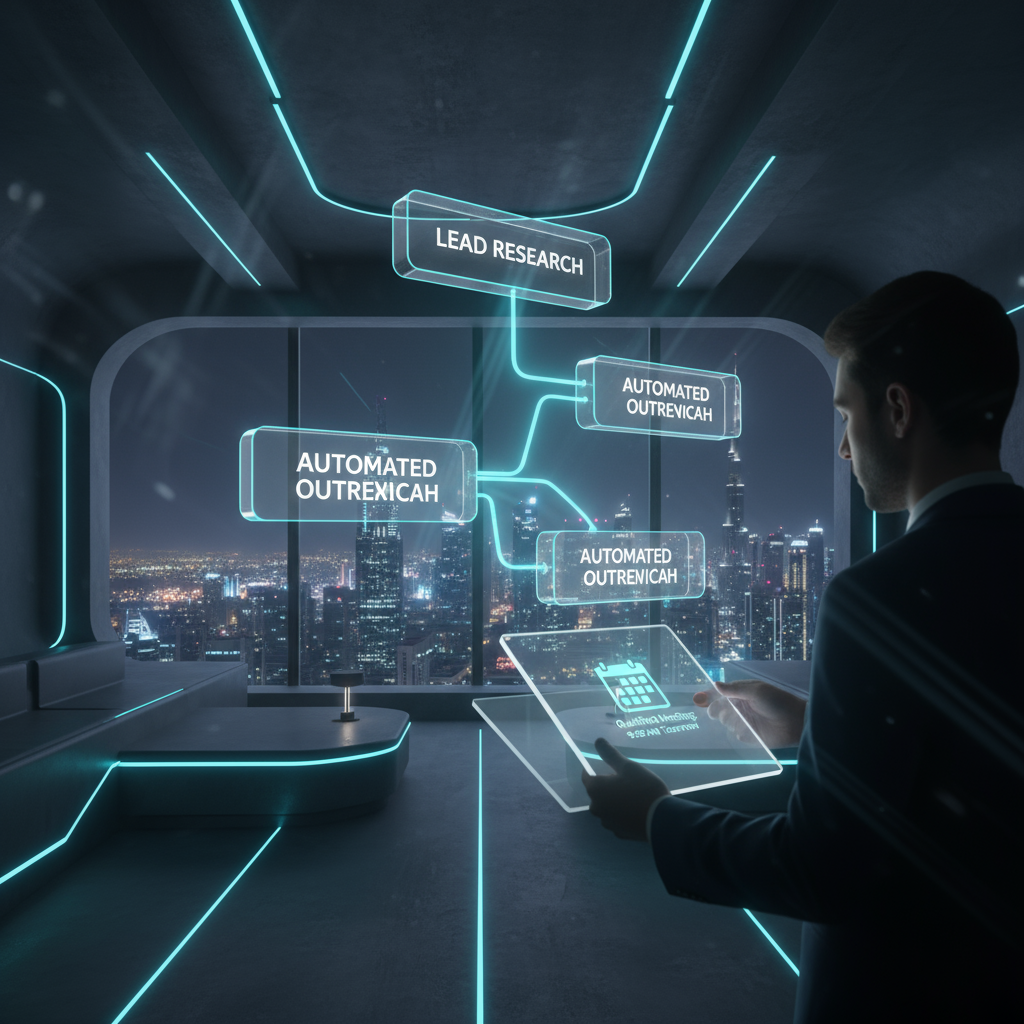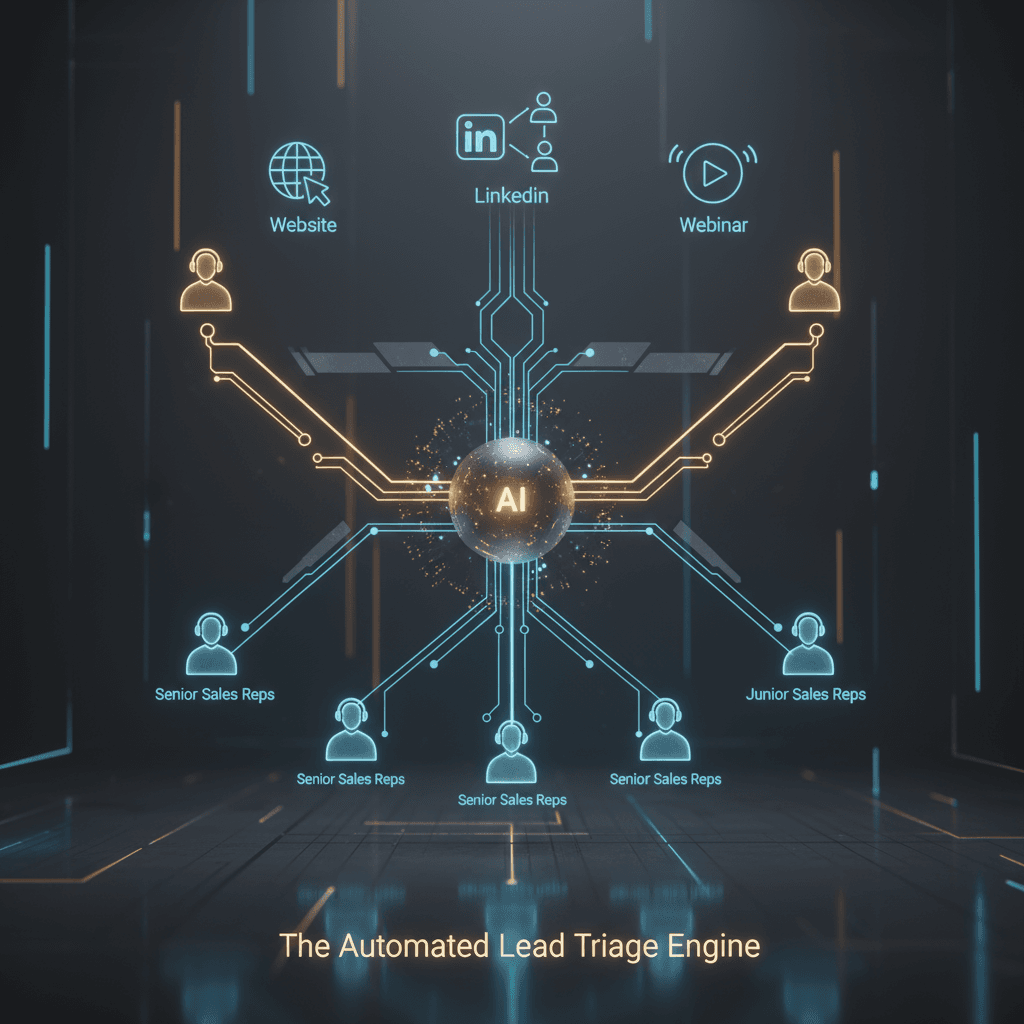How to Build an AI Lead Generation Agent That Actually Works
Stop burning cash on manual prospecting that yields inconsistent results. This is a practical guide to building an autonomous AI agent that finds, qualifies, and engages leads 24/7, filling your pipeline with genuinely interested buyers.
Your SDRs are Expensive and Inconsistent. There’s a Better Way.
Hiring, training, and managing a team of Sales Development Reps (SDRs) is one of the biggest bottlenecks for B2B growth. You spend months ramping them up, only to see inconsistent pipelines and high turnover. The old model of manual list-building, cold emailing, and repetitive follow-ups is broken. It’s too slow, too expensive, and doesn't scale predictably.
But what if you could deploy a digital team member that works around the clock, never has a bad day, and executes a perfect prospecting strategy every single time? That’s not science fiction; it’s an AI Lead Generation Agent. Let's map out how to build one that delivers measurable results, fast.
Key Takeaways: Why an AI Agent Outperforms a Human Team
- Drastically Lower Cost-per-Lead: Slash your customer acquisition costs by automating the most time-consuming parts of the sales funnel—research, outreach, and initial qualification.
- Go from Idea to Pipeline in Weeks, Not Quarters: Deploy a fully trained agent in 2–3 weeks, compared to the 3–6 months it takes to ramp a new human SDR.
- Execute with 100% Consistency: Your AI agent follows your exact playbook for ICP definition, messaging, and follow-up sequences without deviation, ensuring no lead is ever missed.
- Scale Outreach Instantly: Need to target a new market in the DIFC or ADGM? An AI agent can scale its outreach from 100 to 10,000 prospects overnight without a drop in quality.
- Get Actionable Data, Not Excuses: Benchmark messaging, channels, and ICPs with clean data. The agent’s performance is transparent and measurable from day one.

The Old Way vs. The New Way
Understanding the shift is critical. Manual lead generation is a linear process; AI-driven generation is an exponential one.
- Before: An SDR spends ~70% of their day on repetitive, low-value tasks like finding contact data and sending generic emails. The result? A handful of qualified meetings per week, if you're lucky. After 12 months, our client’s cost per demo booked was over $450.
- After: An AI agent automates the entire top-of-funnel. It identifies ideal customers from data sources, validates their contact info, and runs personalized multi-channel outreach. Within 30 days of deploying their first agent, the same client saw their cost per demo drop to $95 and their demo bookings increase by 22%.
The 5-Step Framework to Build Your First AI Lead Gen Agent
Building an effective AI agent isn't about plugging into a magical piece of software. It's a structured process of defining strategy and then automating its execution. Follow these steps to get it right.
- Step 1: Define Your Ideal Customer Profile (ICP) & Triggers
Get painfully specific. Go beyond industry and company size. What are the buying triggers? (e.g., recently hired a VP of Sales, just raised a Series A, posted a job for a specific tech stack). The agent will use these triggers to identify high-intent prospects. - Step 2: Map Your Outreach Channels & Sequence
Where do your buyers live? LinkedIn, email, a specific industry community? Map out a multi-touch sequence. For example: a LinkedIn connection request, followed by an email 24 hours later, and a value-add comment on a recent post three days after that. You can build an AI workforce to handle each channel. - Step 3: Wire the Agent’s "Brain" and Tools
This is the technical core. Your agent needs a central logic unit (the "brain") and access to tools (APIs) to execute tasks. A typical stack includes:- Data Sources: Apollo.io, LinkedIn Sales Navigator, Clay
- Communication: Instantly.ai for email, an API for LinkedIn actions
- Enrichment: Tools to verify emails and find extra data points
- CRM: HubSpot or Salesforce to log all activity
- Step 4: Write Your Messaging Playbook
Create a library of email and LinkedIn message templates. Use placeholders for personalization based on the trigger events you defined in Step 1. The agent will pull from this playbook to run A/B tests and optimize its approach. - Step 5: Define the Handoff Protocol
What criteria makes a lead "sales-qualified"? When a prospect replies with positive intent (e.g., "This sounds interesting, tell me more"), the agent must have a clear rule to flag this, stop all automated follow-ups, and create a task for a human Account Executive to take over. This prevents embarrassing overlaps and ensures a smooth customer experience.

Ready to see it in action?
Stop theorizing and start building. Book a 15-minute demo, and we’ll map your first AI lead generation agent with you, live. Go from concept to qualified pipeline in under three weeks.
Frequently Asked Questions (FAQ)
How much does it cost to build and run an AI lead gen agent?
The cost typically breaks down into platform/development fees and the cost of the tool stack (APIs). It's significantly less than a fully-loaded SDR salary. An effective agent can often operate for less than 20% of the cost of a human employee, delivering 3-5x the output.
How long does it take to deploy?
Unlike the months it takes to hire and train an SDR, a well-defined AI agent can be scoped, built, and deployed in 2 to 4 weeks. The key is having a clear ICP and messaging strategy from the start.
Does this work in the UAE and wider GCC region?
Yes. In fact, it's particularly effective here. Agents can be programmed to identify companies within specific free zones (like DIFC, ADGM), target decision-makers who have recently relocated to Dubai, and operate within local data privacy laws like the PDPL.
What skills do I need on my team to manage this?
You don't need a team of data scientists. You need one "operator"—someone who understands your sales process and can think logically about workflows. They will work with us to oversee the agent's strategy and performance, but the agent handles the execution. Learn more about who we are and how we support you.
How does the AI handle human-like conversations?
The AI agent's primary job is to handle the first 90% of outreach—the structured, repetitive communication. It's designed to identify buying intent. Once a human responds with a genuine question or interest, the agent hands the conversation off to a human sales rep to ensure a high-quality, personal interaction.
What happens if our sales strategy changes?
An AI agent is far more adaptable than a human team. Updating its targeting parameters, messaging, or outreach sequence can be done in hours, not weeks of retraining. This allows you to pivot your GTM strategy almost instantly.
Can this integrate with our existing CRM like HubSpot?
Absolutely. Integration is a core part of the process. The agent will log all activities, update contact records, and create tasks directly in your CRM, ensuring all data is centralized and your sales team has full visibility.
Your Next Steps to an Automated Pipeline
Moving from a manual to an automated sales engine is a structured process, not a wish. Here’s how to start today:
- Audit Your Current Process: Document every step your SDRs currently take to find and qualify a lead. Identify the biggest time sinks.
- Define One Clear Use Case: Don't try to automate everything at once. Pick one specific segment or offer to build your first agent around.
- Benchmark Your Metrics: Know your current cost-per-lead and conversion rates. This will be the baseline you use to measure the agent's success.
- Talk to an Expert: Schedule a call with a team that has done this before. An expert can help you avoid common pitfalls and accelerate your path to a predictable, scalable pipeline. Check out more on our blog.



